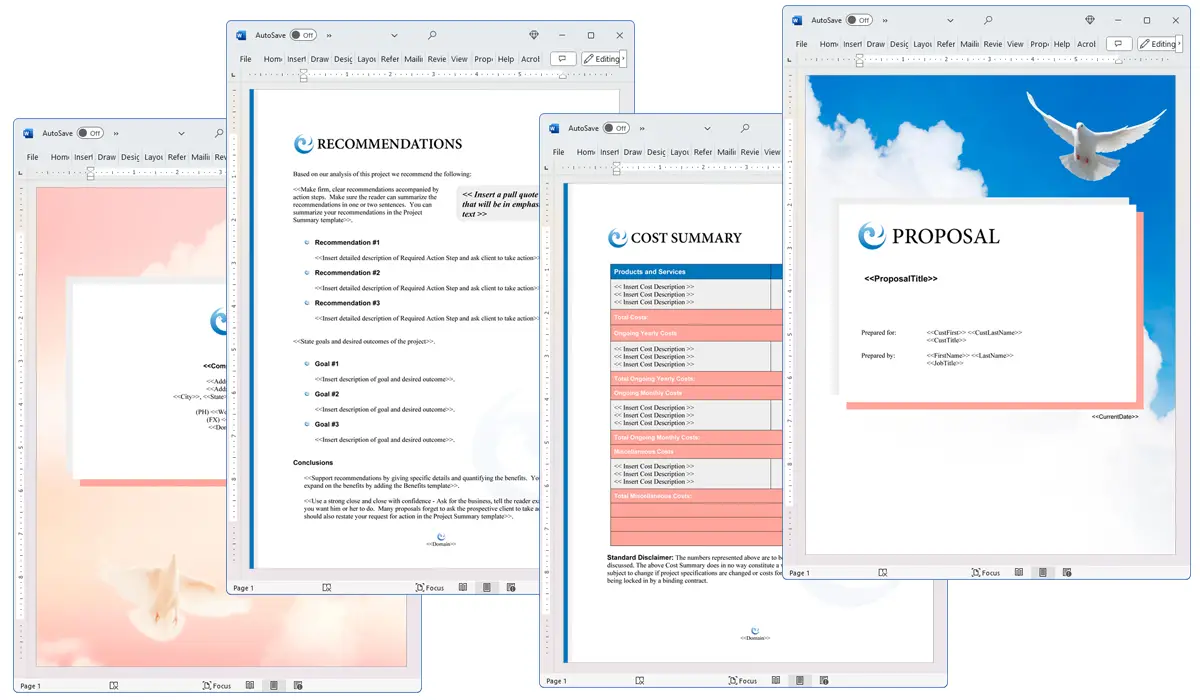What is the Complexity Cost chapter used for?
Proposal Kit Professional Bundle adds more design themes, all six Contract Packs,
a project management library, and Expert Edition software.

Illustration of Proposal Pack Elegant #5
We include this Complexity Cost chapter template in every Proposal Pack, along with thousands more. You assemble this chapter with others in various combinations to create custom-tailored business proposals, plans, reports, and other documents. Proposal Packs apply custom visual designs to the templates, giving the final documents a consistent professional finish.
 DOWNLOADABLE, ONE-TIME COST, NO SUBSCRIPTION FEES
DOWNLOADABLE, ONE-TIME COST, NO SUBSCRIPTION FEES
Overview of the Complexity Cost Chapter
When creating a business proposal, particularly in fields like software and mechanical engineering, understanding and conveying the cost implications of complexity in a project is crucial. The Complexity Cost chapter is a specialized tool in the Proposal Kit library designed to help professionals articulate these often overlooked expenses. This chapter helps outline the long-term financial impact that complex features or processes might have on a project, beyond just the initial spending.
How is the Complexity Cost Chapter Used?
In a business proposal, the Complexity Cost chapter serves a function by illuminating the hidden costs associated with adding complex features or technologies to a project. This part of the proposal is crucial for stakeholders to understand the total economic impact of their decisions. It aids in decision-making by comparing the benefits of a feature against its long-term costs, helping clients and project teams align on the most cost-effective and efficient strategies.
What is Included in the Complexity Cost Chapter?
Typically, this chapter includes several key elements:
- Definition of Complexity: Clarifies what complexity means withconsidering the situation of the specific project.
- Identification of Complex Features: Lists the features or processes considered complex and why.
- Cost Analysis: Provides a detailed breakdown of the costs associated with these complexities. This can include development, implementation, maintenance, and potential disruption costs.
- Comparative Scenarios: Offers comparisons to show costs with and without the complex features.
- Long-Term Financial Impact: Projects the long-term financial implications of introducing complex features, considering factors like additional training, support, and potential downtimes.
Use Case Examples for the Complexity Cost Chapter
This chapter can be tailored to a wide array of industries within various proposals, including:
- Software Development: Estimating the cost of adding artificial intelligence capabilities to a business application.
- Hardware Manufacturing: Analyzing the financial implications of using advanced materials in consumer electronics.
- Technical Automation: Cost assessment for automating a production line in a manufacturing plant.
- Aerospace Engineering: Evaluating the expenses tied to integrating state-of-the-art navigation systems.
- Supply Chain Management: Determining the cost of introducing an automated logistics system.
- Energy Projects: Projecting the complexity costs of deploying a new renewable energy technology.
- Financial Services: Assessing the impact of implementing complex regulatory compliance software.
Key Takeaways
- The Complexity Cost chapter is important for detailing the hidden costs of complex features in engineering projects.
- It aids stakeholders in understanding the full financial implications of their project decisions.
- This chapter includes definitions, cost analysis, and comparative financial scenarios.
- It is applicable across various industries from software to aerospace and energy.
- Using the Complexity Cost chapter can lead to more informed decision-making and potentially significant cost savings in long-term project planning.

Illustration of Proposal Pack Transportation #11
 What Our Clients Say
What Our Clients SayThe Proposal Packs, wizard, and Estimate templates helped me to organize my thoughts and allowed me to focus on the substance of the proposals, rather than the logistics of creating them. We are now able to produce high-quality proposals very efficiently."
Director, Design & Technology
ThingsEternal Strategic Solutions
 4.7 stars, based on 845 reviews
4.7 stars, based on 845 reviewsRelated Chapters

The Complexity Cost chapter and other chapters are integrated into a Word document as illustrated here in the Proposal Pack Telecom #3 design theme. There are hundreds of design themes available, and every design theme includes the Complexity Cost chapter template.
A proper business proposal will include multiple chapters. This chapter is just one of many you can build into your proposal. We include the complete fill-in-the-blank template in our Proposal Pack template collections. We also include a library of sample proposals illustrating how companies in different industries, both large and small, have written proposals using our Proposal Packs. This template will show you how to write the Complexity Cost.
We include a chapter library for you to build from based on your needs. All proposals are different and have different needs and goals. Pick the chapters from our collection and organize them as needed for your proposal.
Using the Proposal Pack template library, you can create any business proposal, report, study, plan, or document.
 Ian Lauder has been helping businesses write their proposals and contracts for two decades. Ian is the owner and founder of Proposal Kit, one of the original sources of business proposal and contract software products started in 1997.
Ian Lauder has been helping businesses write their proposals and contracts for two decades. Ian is the owner and founder of Proposal Kit, one of the original sources of business proposal and contract software products started in 1997.By Ian Lauder
 Published by Proposal Kit, Inc.
Published by Proposal Kit, Inc.


 Cart
Cart
 Facebook
Facebook YouTube
YouTube X
X Search Site
Search Site